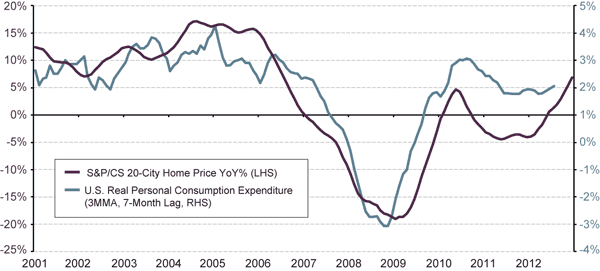Excess Liquidity Finds a Home
U.S. home prices appear likely to continue to rise as the Federal Reserve injects more liquidity into the system. Given housing’s unique characteristics, this will have positive effects for consumption and growth.
by Scott Minerd, Chief Investment Officer, Guggenheim Partners LLC
“The asset category which is best positioned to benefit from the Federal Reserve’s ongoing accommodation appears to be the $18 trillion U.S. housing market. Part of the appeal for the Fed in a run-up in housing is that real estate can be levered up to five times, and is not marked-to-market, so long as prices are appreciating. I would not be surprised to see housing in certain states, such as California, enjoy price appreciation of 10-15% per annum for the next four years. If a home owner is levered, with only 20% down, and the asset appreciates 50%, that equates to a return of approximately 250% on the investment. Furthermore, the wealth effect is much more profound from housing than financial assets. More people own homes than stocks, making it a more pervasive asset class, and people tend to view increasing home values as more permanent than gains in their stock positions.”
Economic Data Releases
Strong Employment Numbers Across the Board
- Non-farm payrolls jumped more than expected in February, rising to 236,000 after a revised gain of 119,000 in January.
- Hourly earnings were up 0.2% and weekly working hours also rose.
- The unemployment rate fell to a four-year low of 7.7% in February, due to payroll gains and a declining labor force.
- Initial jobless claims fell by 7,000 for the week ended March 2nd to 340,000, the lowest in six weeks.
- Factory orders fell 2.0% in January, the largest decrease in five months.
- Wholesale inventories increased 1.2% in January, the largest one-month increase since December 2011.
- The trade deficit widened in January to $44.4 billion, led by increases in oil imports.
- NFIB small business optimism rose for the third consecutive month, reaching 90.8 in February.
Industrial Production Disappoints in Europe and China
- Eurozone GDP contracted 0.6% in the fourth quarter, the fifth consecutive quarter of negative growth.
- German industrial production was flat in January, missing projected growth.
- French industrial production fell 1.2% in January, a larger-than-anticipated contraction.
- Industrial production in the U.K. unexpectedly fell in January, dropping 1.2% after two months of positive growth.
- China’s industrial production disappointed, expanding at a cumulative 9.9% in January and February, the slowest year-over-year pace since 2009.
- Retail sales in China also missed forecasts, expanding at 12.3% the past two months, the weakest yearly start since 2005.
- China’s consumer price index rose 3.2% year-over-year in February, the fastest pace in ten months.
- China’s exports far exceeded estimates in February, rising 21.8% from a year earlier.
- Japan’s GDP in the fourth quarter was revised to positive growth on an annualized basis, moving to 0.2% from the -0.4% initial estimate.
Chart of the Week
Rising Home Prices Will Lift Consumption
U.S. home prices rose 6.8% year-over-year in December, the fastest 12-month growth since July 2006. Historically, home price appreciation has led to increases in real household consumption via the wealth effect. Homeowners tend to spend more when their net worth increases. A recent study by the Federal Reserve estimated that the wealth effect from rising home prices has four times the effect of the change in wealth effect from rising financial asset prices. As the housing market continues to recover, consumption can be expected to follow accordingly.
U.S. S&P/CS HOME PRICE VS. REAL PERSONAL CONSUMPTION EXPENDITURE

Source: Bloomberg, Guggenheim Investments. U.S. Real Personal Consumption Expenditure data as of 12/31/2012. Remaining data as of 1/31/2013.
This article is distributed for informational purposes only and should not be considered as investing advice or a recommendation of any particular security, strategy or investment product. This article contains opinions of the author but not necessarily those of Guggenheim Partners or its subsidiaries. The author’s opinions are subject to change without notice. Forward looking statements, estimates, and certain information contained herein are based upon proprietary and non-proprietary research and other sources. Information contained herein has been obtained from sources believed to be reliable, but are not assured as to accuracy. No part of this article may be reproduced in any form, or referred to in any other publication, without express written permission of Guggenheim Partners, LLC. ©2013, Guggenheim Partners. Past performance is not indicative of future results. There is neither representation nor warranty as to the current accuracy of, nor liability for, decisions based on such information.
Copyright © Guggenheim Partners LLC











